Examining Service Quality and Customer Satisfaction in ITC Grand Chola
VerifiedAdded on 2022/08/21
|14
|3861
|19
Report
AI Summary
This report investigates the impact of service quality on customer satisfaction and consumer loyalty at ITC Grand Chola, a luxury hotel in Chennai, India. The study aims to examine the elements of service quality, customer satisfaction, and the relationship between them, using the SERVQUAL model and other relevant literature. The research employs a quantitative approach with a survey of 250 consumers to analyze the influence of service quality on consumer satisfaction and loyalty. The report reviews existing research on service quality, customer satisfaction, and loyalty within the hospitality industry. The research questions address the elements of service quality, aspects of customer satisfaction, the relationship between them, and how they affect consumer loyalty. The hypothesis suggests a positive relationship between service quality and customer satisfaction, and a significant impact of these factors on consumer loyalty. The study adopts a mono method with a positivism philosophy and a deductive approach, utilizing the Saunders research onion as a framework. The report provides a detailed analysis of the research methodology, including the sampling techniques, time horizon, and ethical considerations. The findings aim to recommend strategies for improving customer satisfaction, service quality, and consumer retention rates within ITC Grand Chola.
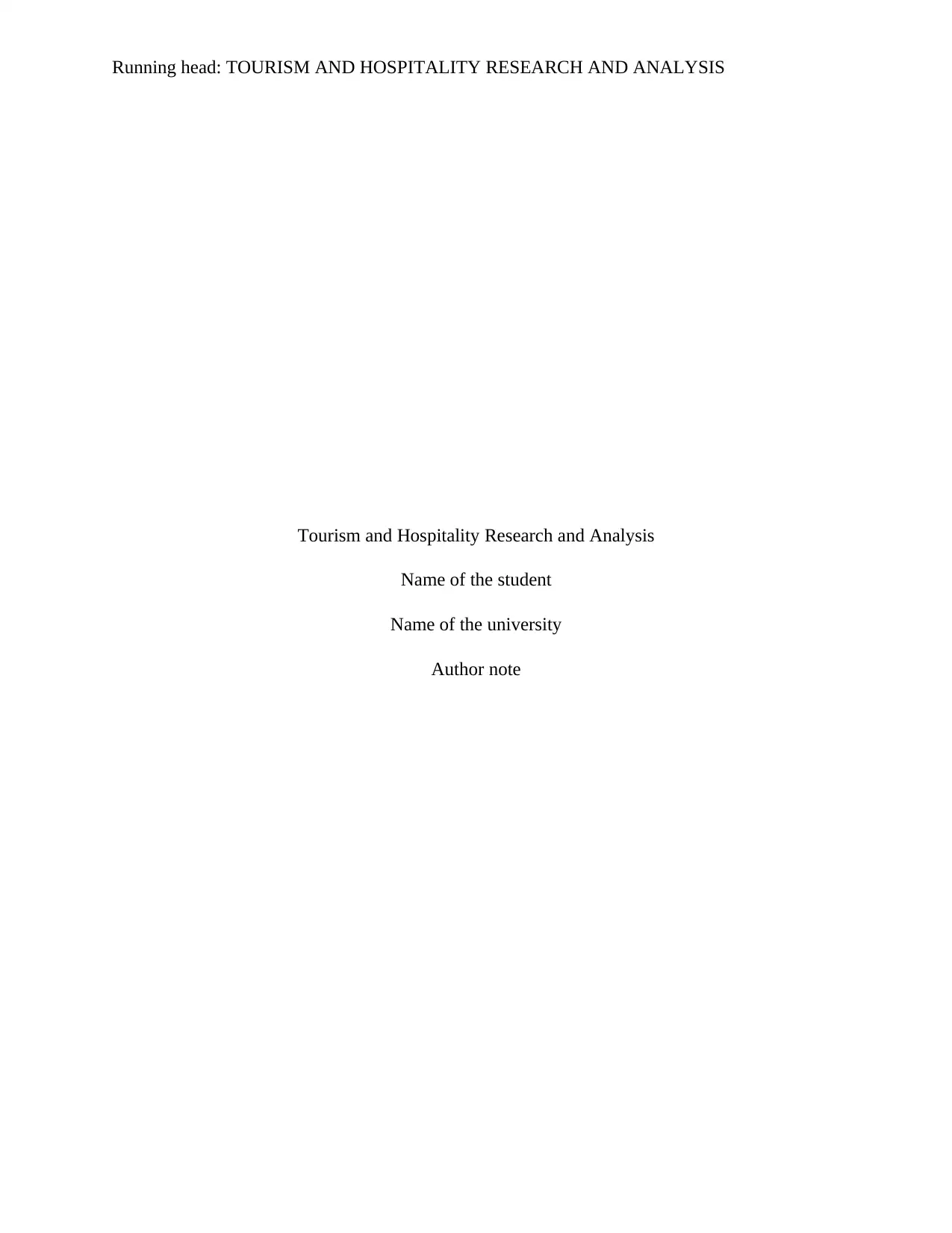
Running head: TOURISM AND HOSPITALITY RESEARCH AND ANALYSIS
Tourism and Hospitality Research and Analysis
Name of the student
Name of the university
Author note
Tourism and Hospitality Research and Analysis
Name of the student
Name of the university
Author note
Paraphrase This Document
Need a fresh take? Get an instant paraphrase of this document with our AI Paraphraser
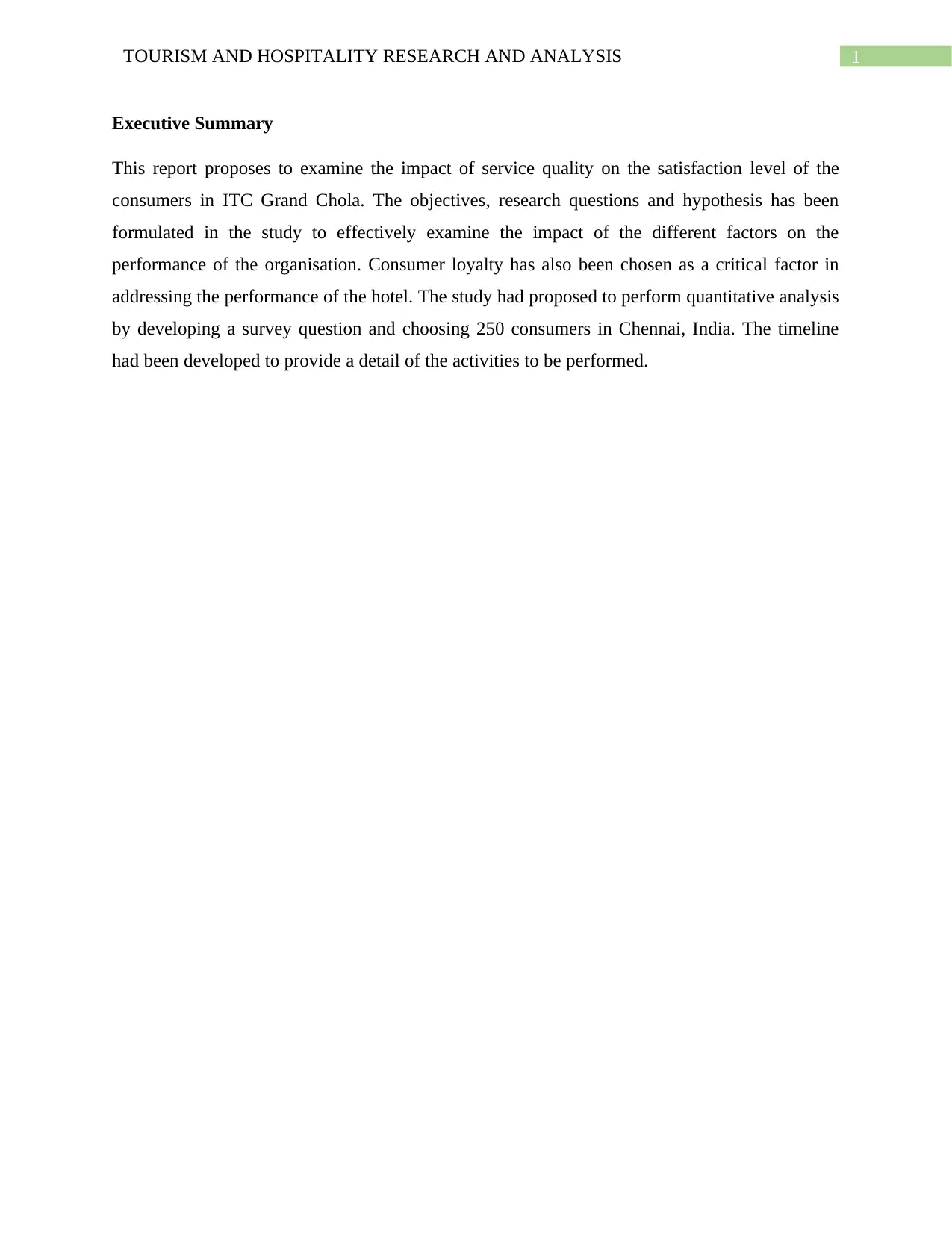
1TOURISM AND HOSPITALITY RESEARCH AND ANALYSIS
Executive Summary
This report proposes to examine the impact of service quality on the satisfaction level of the
consumers in ITC Grand Chola. The objectives, research questions and hypothesis has been
formulated in the study to effectively examine the impact of the different factors on the
performance of the organisation. Consumer loyalty has also been chosen as a critical factor in
addressing the performance of the hotel. The study had proposed to perform quantitative analysis
by developing a survey question and choosing 250 consumers in Chennai, India. The timeline
had been developed to provide a detail of the activities to be performed.
Executive Summary
This report proposes to examine the impact of service quality on the satisfaction level of the
consumers in ITC Grand Chola. The objectives, research questions and hypothesis has been
formulated in the study to effectively examine the impact of the different factors on the
performance of the organisation. Consumer loyalty has also been chosen as a critical factor in
addressing the performance of the hotel. The study had proposed to perform quantitative analysis
by developing a survey question and choosing 250 consumers in Chennai, India. The timeline
had been developed to provide a detail of the activities to be performed.

2TOURISM AND HOSPITALITY RESEARCH AND ANALYSIS
Table of Contents
Background of the study..................................................................................................................3
Rationale..........................................................................................................................................4
Aim and objectives..........................................................................................................................4
Research questions.......................................................................................................................5
Research Hypothesis....................................................................................................................5
Literature review..............................................................................................................................5
Research Methods............................................................................................................................7
Timescale.........................................................................................................................................9
References......................................................................................................................................11
Table of Contents
Background of the study..................................................................................................................3
Rationale..........................................................................................................................................4
Aim and objectives..........................................................................................................................4
Research questions.......................................................................................................................5
Research Hypothesis....................................................................................................................5
Literature review..............................................................................................................................5
Research Methods............................................................................................................................7
Timescale.........................................................................................................................................9
References......................................................................................................................................11
⊘ This is a preview!⊘
Do you want full access?
Subscribe today to unlock all pages.

Trusted by 1+ million students worldwide
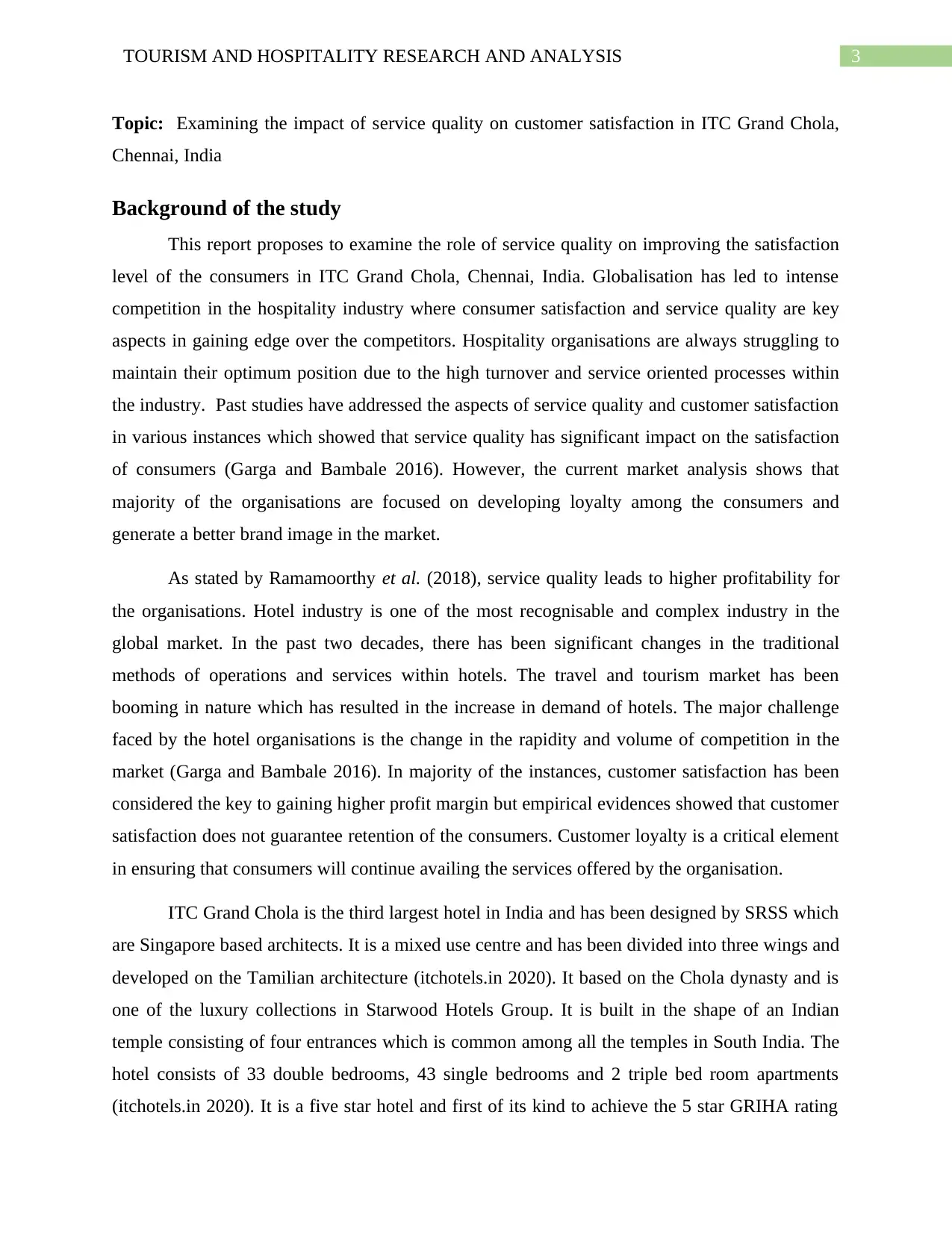
3TOURISM AND HOSPITALITY RESEARCH AND ANALYSIS
Topic: Examining the impact of service quality on customer satisfaction in ITC Grand Chola,
Chennai, India
Background of the study
This report proposes to examine the role of service quality on improving the satisfaction
level of the consumers in ITC Grand Chola, Chennai, India. Globalisation has led to intense
competition in the hospitality industry where consumer satisfaction and service quality are key
aspects in gaining edge over the competitors. Hospitality organisations are always struggling to
maintain their optimum position due to the high turnover and service oriented processes within
the industry. Past studies have addressed the aspects of service quality and customer satisfaction
in various instances which showed that service quality has significant impact on the satisfaction
of consumers (Garga and Bambale 2016). However, the current market analysis shows that
majority of the organisations are focused on developing loyalty among the consumers and
generate a better brand image in the market.
As stated by Ramamoorthy et al. (2018), service quality leads to higher profitability for
the organisations. Hotel industry is one of the most recognisable and complex industry in the
global market. In the past two decades, there has been significant changes in the traditional
methods of operations and services within hotels. The travel and tourism market has been
booming in nature which has resulted in the increase in demand of hotels. The major challenge
faced by the hotel organisations is the change in the rapidity and volume of competition in the
market (Garga and Bambale 2016). In majority of the instances, customer satisfaction has been
considered the key to gaining higher profit margin but empirical evidences showed that customer
satisfaction does not guarantee retention of the consumers. Customer loyalty is a critical element
in ensuring that consumers will continue availing the services offered by the organisation.
ITC Grand Chola is the third largest hotel in India and has been designed by SRSS which
are Singapore based architects. It is a mixed use centre and has been divided into three wings and
developed on the Tamilian architecture (itchotels.in 2020). It based on the Chola dynasty and is
one of the luxury collections in Starwood Hotels Group. It is built in the shape of an Indian
temple consisting of four entrances which is common among all the temples in South India. The
hotel consists of 33 double bedrooms, 43 single bedrooms and 2 triple bed room apartments
(itchotels.in 2020). It is a five star hotel and first of its kind to achieve the 5 star GRIHA rating
Topic: Examining the impact of service quality on customer satisfaction in ITC Grand Chola,
Chennai, India
Background of the study
This report proposes to examine the role of service quality on improving the satisfaction
level of the consumers in ITC Grand Chola, Chennai, India. Globalisation has led to intense
competition in the hospitality industry where consumer satisfaction and service quality are key
aspects in gaining edge over the competitors. Hospitality organisations are always struggling to
maintain their optimum position due to the high turnover and service oriented processes within
the industry. Past studies have addressed the aspects of service quality and customer satisfaction
in various instances which showed that service quality has significant impact on the satisfaction
of consumers (Garga and Bambale 2016). However, the current market analysis shows that
majority of the organisations are focused on developing loyalty among the consumers and
generate a better brand image in the market.
As stated by Ramamoorthy et al. (2018), service quality leads to higher profitability for
the organisations. Hotel industry is one of the most recognisable and complex industry in the
global market. In the past two decades, there has been significant changes in the traditional
methods of operations and services within hotels. The travel and tourism market has been
booming in nature which has resulted in the increase in demand of hotels. The major challenge
faced by the hotel organisations is the change in the rapidity and volume of competition in the
market (Garga and Bambale 2016). In majority of the instances, customer satisfaction has been
considered the key to gaining higher profit margin but empirical evidences showed that customer
satisfaction does not guarantee retention of the consumers. Customer loyalty is a critical element
in ensuring that consumers will continue availing the services offered by the organisation.
ITC Grand Chola is the third largest hotel in India and has been designed by SRSS which
are Singapore based architects. It is a mixed use centre and has been divided into three wings and
developed on the Tamilian architecture (itchotels.in 2020). It based on the Chola dynasty and is
one of the luxury collections in Starwood Hotels Group. It is built in the shape of an Indian
temple consisting of four entrances which is common among all the temples in South India. The
hotel consists of 33 double bedrooms, 43 single bedrooms and 2 triple bed room apartments
(itchotels.in 2020). It is a five star hotel and first of its kind to achieve the 5 star GRIHA rating
Paraphrase This Document
Need a fresh take? Get an instant paraphrase of this document with our AI Paraphraser
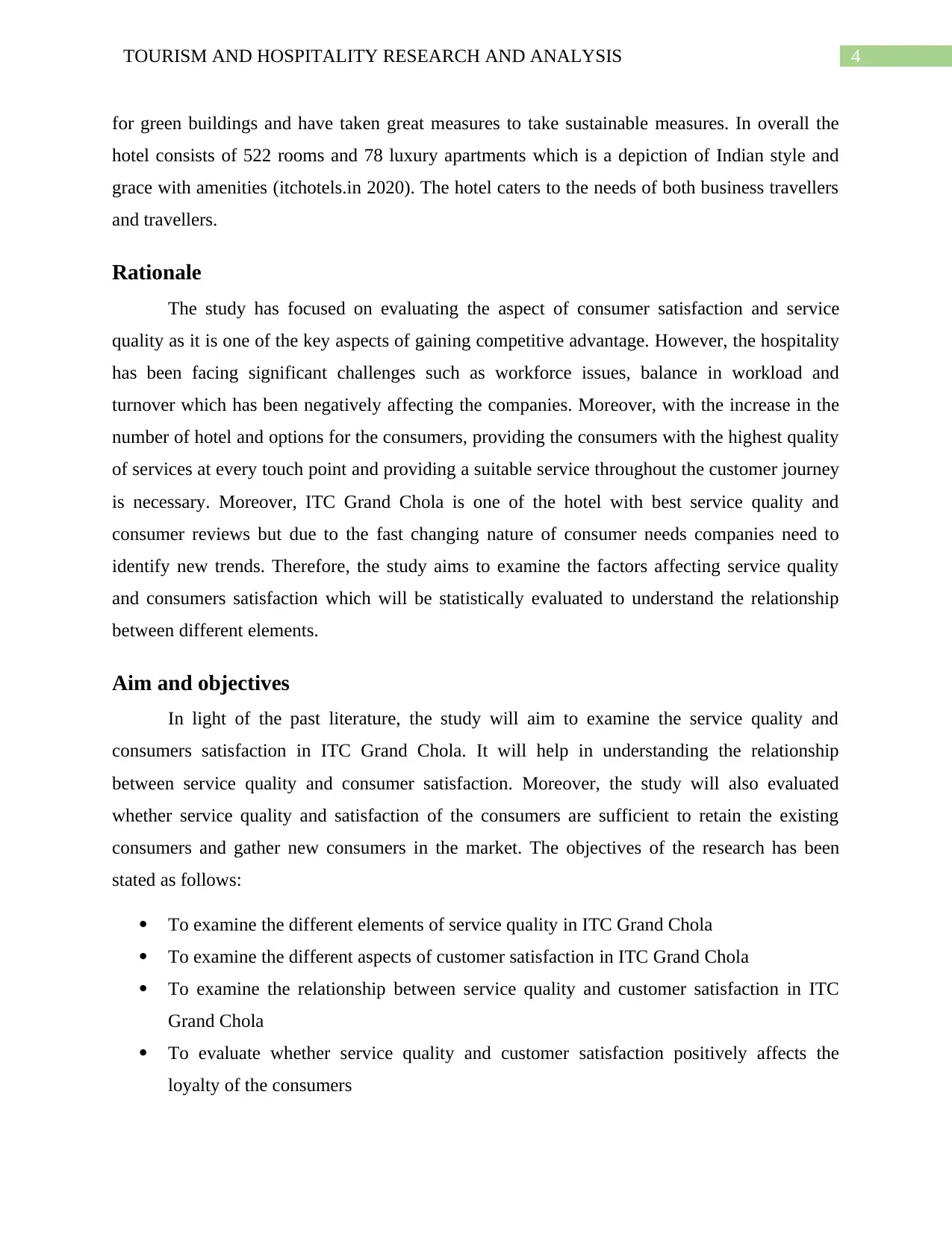
4TOURISM AND HOSPITALITY RESEARCH AND ANALYSIS
for green buildings and have taken great measures to take sustainable measures. In overall the
hotel consists of 522 rooms and 78 luxury apartments which is a depiction of Indian style and
grace with amenities (itchotels.in 2020). The hotel caters to the needs of both business travellers
and travellers.
Rationale
The study has focused on evaluating the aspect of consumer satisfaction and service
quality as it is one of the key aspects of gaining competitive advantage. However, the hospitality
has been facing significant challenges such as workforce issues, balance in workload and
turnover which has been negatively affecting the companies. Moreover, with the increase in the
number of hotel and options for the consumers, providing the consumers with the highest quality
of services at every touch point and providing a suitable service throughout the customer journey
is necessary. Moreover, ITC Grand Chola is one of the hotel with best service quality and
consumer reviews but due to the fast changing nature of consumer needs companies need to
identify new trends. Therefore, the study aims to examine the factors affecting service quality
and consumers satisfaction which will be statistically evaluated to understand the relationship
between different elements.
Aim and objectives
In light of the past literature, the study will aim to examine the service quality and
consumers satisfaction in ITC Grand Chola. It will help in understanding the relationship
between service quality and consumer satisfaction. Moreover, the study will also evaluated
whether service quality and satisfaction of the consumers are sufficient to retain the existing
consumers and gather new consumers in the market. The objectives of the research has been
stated as follows:
To examine the different elements of service quality in ITC Grand Chola
To examine the different aspects of customer satisfaction in ITC Grand Chola
To examine the relationship between service quality and customer satisfaction in ITC
Grand Chola
To evaluate whether service quality and customer satisfaction positively affects the
loyalty of the consumers
for green buildings and have taken great measures to take sustainable measures. In overall the
hotel consists of 522 rooms and 78 luxury apartments which is a depiction of Indian style and
grace with amenities (itchotels.in 2020). The hotel caters to the needs of both business travellers
and travellers.
Rationale
The study has focused on evaluating the aspect of consumer satisfaction and service
quality as it is one of the key aspects of gaining competitive advantage. However, the hospitality
has been facing significant challenges such as workforce issues, balance in workload and
turnover which has been negatively affecting the companies. Moreover, with the increase in the
number of hotel and options for the consumers, providing the consumers with the highest quality
of services at every touch point and providing a suitable service throughout the customer journey
is necessary. Moreover, ITC Grand Chola is one of the hotel with best service quality and
consumer reviews but due to the fast changing nature of consumer needs companies need to
identify new trends. Therefore, the study aims to examine the factors affecting service quality
and consumers satisfaction which will be statistically evaluated to understand the relationship
between different elements.
Aim and objectives
In light of the past literature, the study will aim to examine the service quality and
consumers satisfaction in ITC Grand Chola. It will help in understanding the relationship
between service quality and consumer satisfaction. Moreover, the study will also evaluated
whether service quality and satisfaction of the consumers are sufficient to retain the existing
consumers and gather new consumers in the market. The objectives of the research has been
stated as follows:
To examine the different elements of service quality in ITC Grand Chola
To examine the different aspects of customer satisfaction in ITC Grand Chola
To examine the relationship between service quality and customer satisfaction in ITC
Grand Chola
To evaluate whether service quality and customer satisfaction positively affects the
loyalty of the consumers
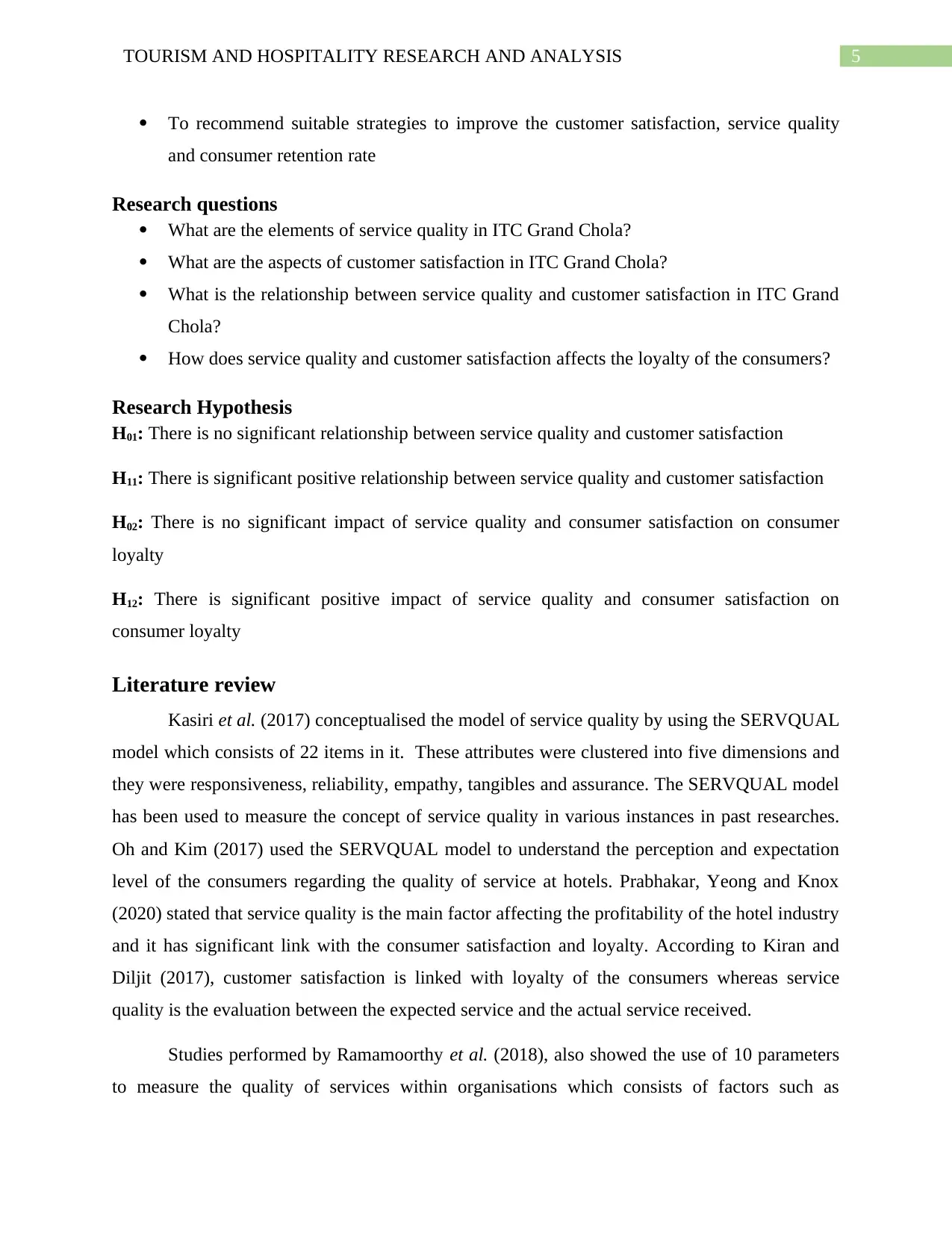
5TOURISM AND HOSPITALITY RESEARCH AND ANALYSIS
To recommend suitable strategies to improve the customer satisfaction, service quality
and consumer retention rate
Research questions
What are the elements of service quality in ITC Grand Chola?
What are the aspects of customer satisfaction in ITC Grand Chola?
What is the relationship between service quality and customer satisfaction in ITC Grand
Chola?
How does service quality and customer satisfaction affects the loyalty of the consumers?
Research Hypothesis
H01: There is no significant relationship between service quality and customer satisfaction
H11: There is significant positive relationship between service quality and customer satisfaction
H02: There is no significant impact of service quality and consumer satisfaction on consumer
loyalty
H12: There is significant positive impact of service quality and consumer satisfaction on
consumer loyalty
Literature review
Kasiri et al. (2017) conceptualised the model of service quality by using the SERVQUAL
model which consists of 22 items in it. These attributes were clustered into five dimensions and
they were responsiveness, reliability, empathy, tangibles and assurance. The SERVQUAL model
has been used to measure the concept of service quality in various instances in past researches.
Oh and Kim (2017) used the SERVQUAL model to understand the perception and expectation
level of the consumers regarding the quality of service at hotels. Prabhakar, Yeong and Knox
(2020) stated that service quality is the main factor affecting the profitability of the hotel industry
and it has significant link with the consumer satisfaction and loyalty. According to Kiran and
Diljit (2017), customer satisfaction is linked with loyalty of the consumers whereas service
quality is the evaluation between the expected service and the actual service received.
Studies performed by Ramamoorthy et al. (2018), also showed the use of 10 parameters
to measure the quality of services within organisations which consists of factors such as
To recommend suitable strategies to improve the customer satisfaction, service quality
and consumer retention rate
Research questions
What are the elements of service quality in ITC Grand Chola?
What are the aspects of customer satisfaction in ITC Grand Chola?
What is the relationship between service quality and customer satisfaction in ITC Grand
Chola?
How does service quality and customer satisfaction affects the loyalty of the consumers?
Research Hypothesis
H01: There is no significant relationship between service quality and customer satisfaction
H11: There is significant positive relationship between service quality and customer satisfaction
H02: There is no significant impact of service quality and consumer satisfaction on consumer
loyalty
H12: There is significant positive impact of service quality and consumer satisfaction on
consumer loyalty
Literature review
Kasiri et al. (2017) conceptualised the model of service quality by using the SERVQUAL
model which consists of 22 items in it. These attributes were clustered into five dimensions and
they were responsiveness, reliability, empathy, tangibles and assurance. The SERVQUAL model
has been used to measure the concept of service quality in various instances in past researches.
Oh and Kim (2017) used the SERVQUAL model to understand the perception and expectation
level of the consumers regarding the quality of service at hotels. Prabhakar, Yeong and Knox
(2020) stated that service quality is the main factor affecting the profitability of the hotel industry
and it has significant link with the consumer satisfaction and loyalty. According to Kiran and
Diljit (2017), customer satisfaction is linked with loyalty of the consumers whereas service
quality is the evaluation between the expected service and the actual service received.
Studies performed by Ramamoorthy et al. (2018), also showed the use of 10 parameters
to measure the quality of services within organisations which consists of factors such as
⊘ This is a preview!⊘
Do you want full access?
Subscribe today to unlock all pages.

Trusted by 1+ million students worldwide
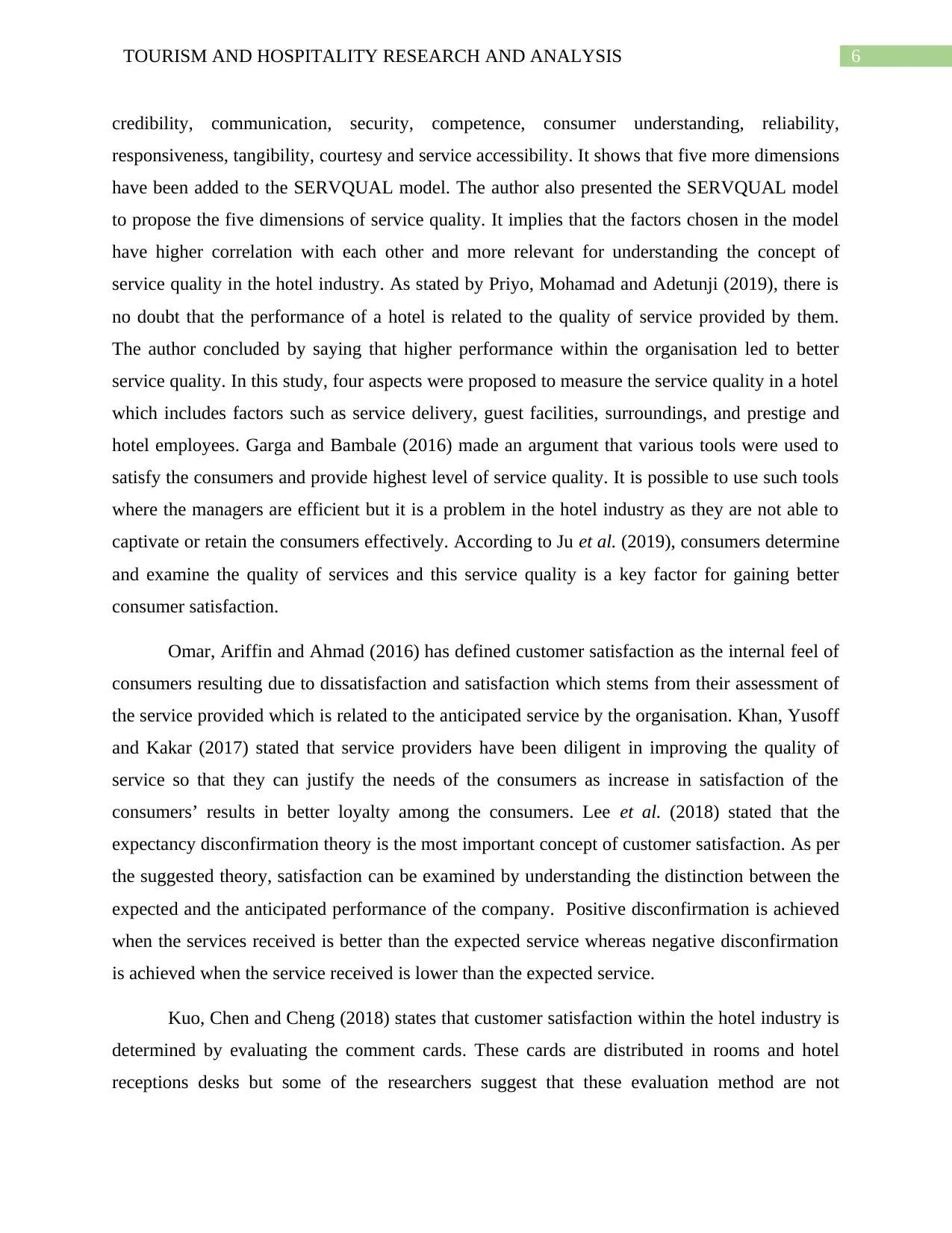
6TOURISM AND HOSPITALITY RESEARCH AND ANALYSIS
credibility, communication, security, competence, consumer understanding, reliability,
responsiveness, tangibility, courtesy and service accessibility. It shows that five more dimensions
have been added to the SERVQUAL model. The author also presented the SERVQUAL model
to propose the five dimensions of service quality. It implies that the factors chosen in the model
have higher correlation with each other and more relevant for understanding the concept of
service quality in the hotel industry. As stated by Priyo, Mohamad and Adetunji (2019), there is
no doubt that the performance of a hotel is related to the quality of service provided by them.
The author concluded by saying that higher performance within the organisation led to better
service quality. In this study, four aspects were proposed to measure the service quality in a hotel
which includes factors such as service delivery, guest facilities, surroundings, and prestige and
hotel employees. Garga and Bambale (2016) made an argument that various tools were used to
satisfy the consumers and provide highest level of service quality. It is possible to use such tools
where the managers are efficient but it is a problem in the hotel industry as they are not able to
captivate or retain the consumers effectively. According to Ju et al. (2019), consumers determine
and examine the quality of services and this service quality is a key factor for gaining better
consumer satisfaction.
Omar, Ariffin and Ahmad (2016) has defined customer satisfaction as the internal feel of
consumers resulting due to dissatisfaction and satisfaction which stems from their assessment of
the service provided which is related to the anticipated service by the organisation. Khan, Yusoff
and Kakar (2017) stated that service providers have been diligent in improving the quality of
service so that they can justify the needs of the consumers as increase in satisfaction of the
consumers’ results in better loyalty among the consumers. Lee et al. (2018) stated that the
expectancy disconfirmation theory is the most important concept of customer satisfaction. As per
the suggested theory, satisfaction can be examined by understanding the distinction between the
expected and the anticipated performance of the company. Positive disconfirmation is achieved
when the services received is better than the expected service whereas negative disconfirmation
is achieved when the service received is lower than the expected service.
Kuo, Chen and Cheng (2018) states that customer satisfaction within the hotel industry is
determined by evaluating the comment cards. These cards are distributed in rooms and hotel
receptions desks but some of the researchers suggest that these evaluation method are not
credibility, communication, security, competence, consumer understanding, reliability,
responsiveness, tangibility, courtesy and service accessibility. It shows that five more dimensions
have been added to the SERVQUAL model. The author also presented the SERVQUAL model
to propose the five dimensions of service quality. It implies that the factors chosen in the model
have higher correlation with each other and more relevant for understanding the concept of
service quality in the hotel industry. As stated by Priyo, Mohamad and Adetunji (2019), there is
no doubt that the performance of a hotel is related to the quality of service provided by them.
The author concluded by saying that higher performance within the organisation led to better
service quality. In this study, four aspects were proposed to measure the service quality in a hotel
which includes factors such as service delivery, guest facilities, surroundings, and prestige and
hotel employees. Garga and Bambale (2016) made an argument that various tools were used to
satisfy the consumers and provide highest level of service quality. It is possible to use such tools
where the managers are efficient but it is a problem in the hotel industry as they are not able to
captivate or retain the consumers effectively. According to Ju et al. (2019), consumers determine
and examine the quality of services and this service quality is a key factor for gaining better
consumer satisfaction.
Omar, Ariffin and Ahmad (2016) has defined customer satisfaction as the internal feel of
consumers resulting due to dissatisfaction and satisfaction which stems from their assessment of
the service provided which is related to the anticipated service by the organisation. Khan, Yusoff
and Kakar (2017) stated that service providers have been diligent in improving the quality of
service so that they can justify the needs of the consumers as increase in satisfaction of the
consumers’ results in better loyalty among the consumers. Lee et al. (2018) stated that the
expectancy disconfirmation theory is the most important concept of customer satisfaction. As per
the suggested theory, satisfaction can be examined by understanding the distinction between the
expected and the anticipated performance of the company. Positive disconfirmation is achieved
when the services received is better than the expected service whereas negative disconfirmation
is achieved when the service received is lower than the expected service.
Kuo, Chen and Cheng (2018) states that customer satisfaction within the hotel industry is
determined by evaluating the comment cards. These cards are distributed in rooms and hotel
receptions desks but some of the researchers suggest that these evaluation method are not
Paraphrase This Document
Need a fresh take? Get an instant paraphrase of this document with our AI Paraphraser
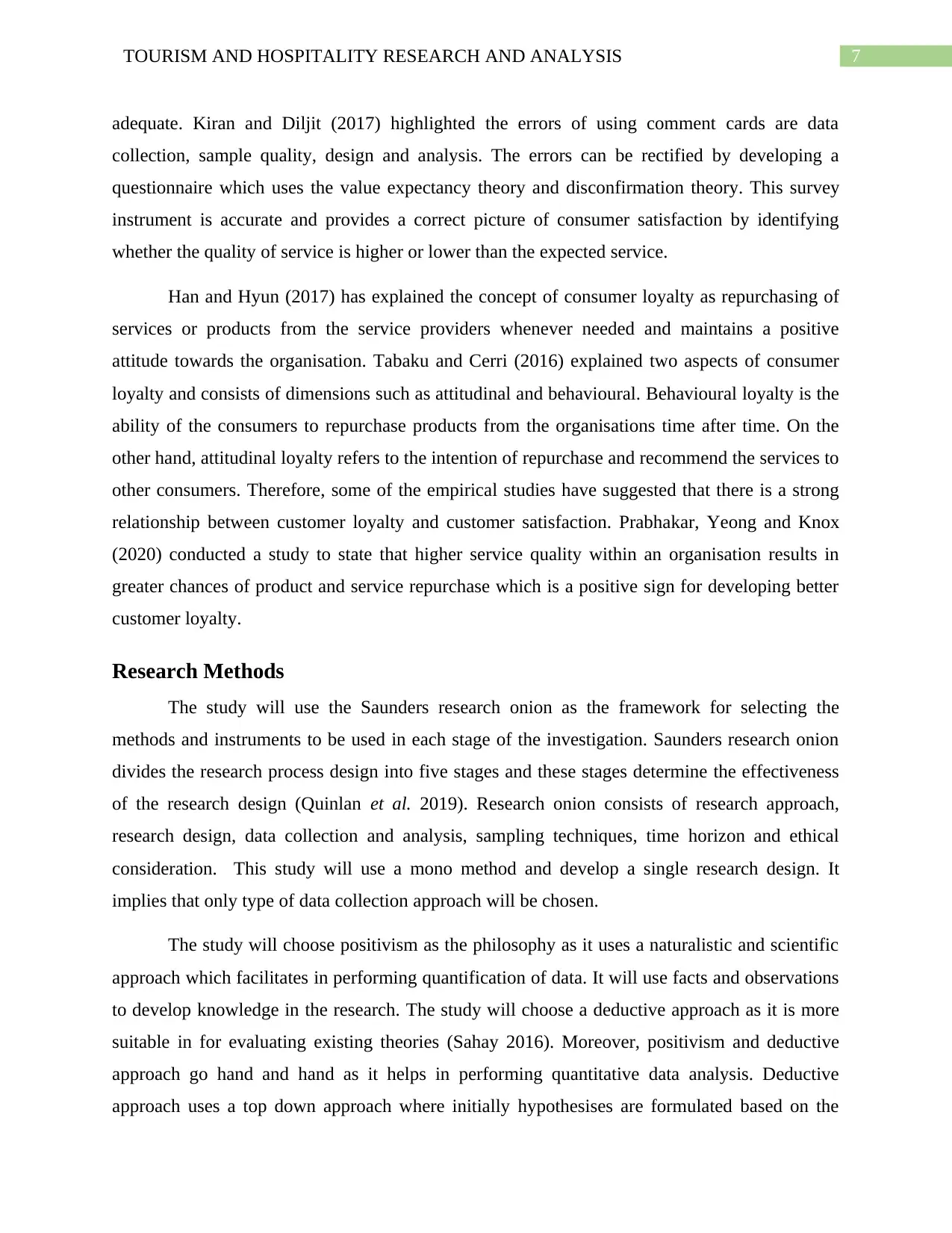
7TOURISM AND HOSPITALITY RESEARCH AND ANALYSIS
adequate. Kiran and Diljit (2017) highlighted the errors of using comment cards are data
collection, sample quality, design and analysis. The errors can be rectified by developing a
questionnaire which uses the value expectancy theory and disconfirmation theory. This survey
instrument is accurate and provides a correct picture of consumer satisfaction by identifying
whether the quality of service is higher or lower than the expected service.
Han and Hyun (2017) has explained the concept of consumer loyalty as repurchasing of
services or products from the service providers whenever needed and maintains a positive
attitude towards the organisation. Tabaku and Cerri (2016) explained two aspects of consumer
loyalty and consists of dimensions such as attitudinal and behavioural. Behavioural loyalty is the
ability of the consumers to repurchase products from the organisations time after time. On the
other hand, attitudinal loyalty refers to the intention of repurchase and recommend the services to
other consumers. Therefore, some of the empirical studies have suggested that there is a strong
relationship between customer loyalty and customer satisfaction. Prabhakar, Yeong and Knox
(2020) conducted a study to state that higher service quality within an organisation results in
greater chances of product and service repurchase which is a positive sign for developing better
customer loyalty.
Research Methods
The study will use the Saunders research onion as the framework for selecting the
methods and instruments to be used in each stage of the investigation. Saunders research onion
divides the research process design into five stages and these stages determine the effectiveness
of the research design (Quinlan et al. 2019). Research onion consists of research approach,
research design, data collection and analysis, sampling techniques, time horizon and ethical
consideration. This study will use a mono method and develop a single research design. It
implies that only type of data collection approach will be chosen.
The study will choose positivism as the philosophy as it uses a naturalistic and scientific
approach which facilitates in performing quantification of data. It will use facts and observations
to develop knowledge in the research. The study will choose a deductive approach as it is more
suitable in for evaluating existing theories (Sahay 2016). Moreover, positivism and deductive
approach go hand and hand as it helps in performing quantitative data analysis. Deductive
approach uses a top down approach where initially hypothesises are formulated based on the
adequate. Kiran and Diljit (2017) highlighted the errors of using comment cards are data
collection, sample quality, design and analysis. The errors can be rectified by developing a
questionnaire which uses the value expectancy theory and disconfirmation theory. This survey
instrument is accurate and provides a correct picture of consumer satisfaction by identifying
whether the quality of service is higher or lower than the expected service.
Han and Hyun (2017) has explained the concept of consumer loyalty as repurchasing of
services or products from the service providers whenever needed and maintains a positive
attitude towards the organisation. Tabaku and Cerri (2016) explained two aspects of consumer
loyalty and consists of dimensions such as attitudinal and behavioural. Behavioural loyalty is the
ability of the consumers to repurchase products from the organisations time after time. On the
other hand, attitudinal loyalty refers to the intention of repurchase and recommend the services to
other consumers. Therefore, some of the empirical studies have suggested that there is a strong
relationship between customer loyalty and customer satisfaction. Prabhakar, Yeong and Knox
(2020) conducted a study to state that higher service quality within an organisation results in
greater chances of product and service repurchase which is a positive sign for developing better
customer loyalty.
Research Methods
The study will use the Saunders research onion as the framework for selecting the
methods and instruments to be used in each stage of the investigation. Saunders research onion
divides the research process design into five stages and these stages determine the effectiveness
of the research design (Quinlan et al. 2019). Research onion consists of research approach,
research design, data collection and analysis, sampling techniques, time horizon and ethical
consideration. This study will use a mono method and develop a single research design. It
implies that only type of data collection approach will be chosen.
The study will choose positivism as the philosophy as it uses a naturalistic and scientific
approach which facilitates in performing quantification of data. It will use facts and observations
to develop knowledge in the research. The study will choose a deductive approach as it is more
suitable in for evaluating existing theories (Sahay 2016). Moreover, positivism and deductive
approach go hand and hand as it helps in performing quantitative data analysis. Deductive
approach uses a top down approach where initially hypothesises are formulated based on the
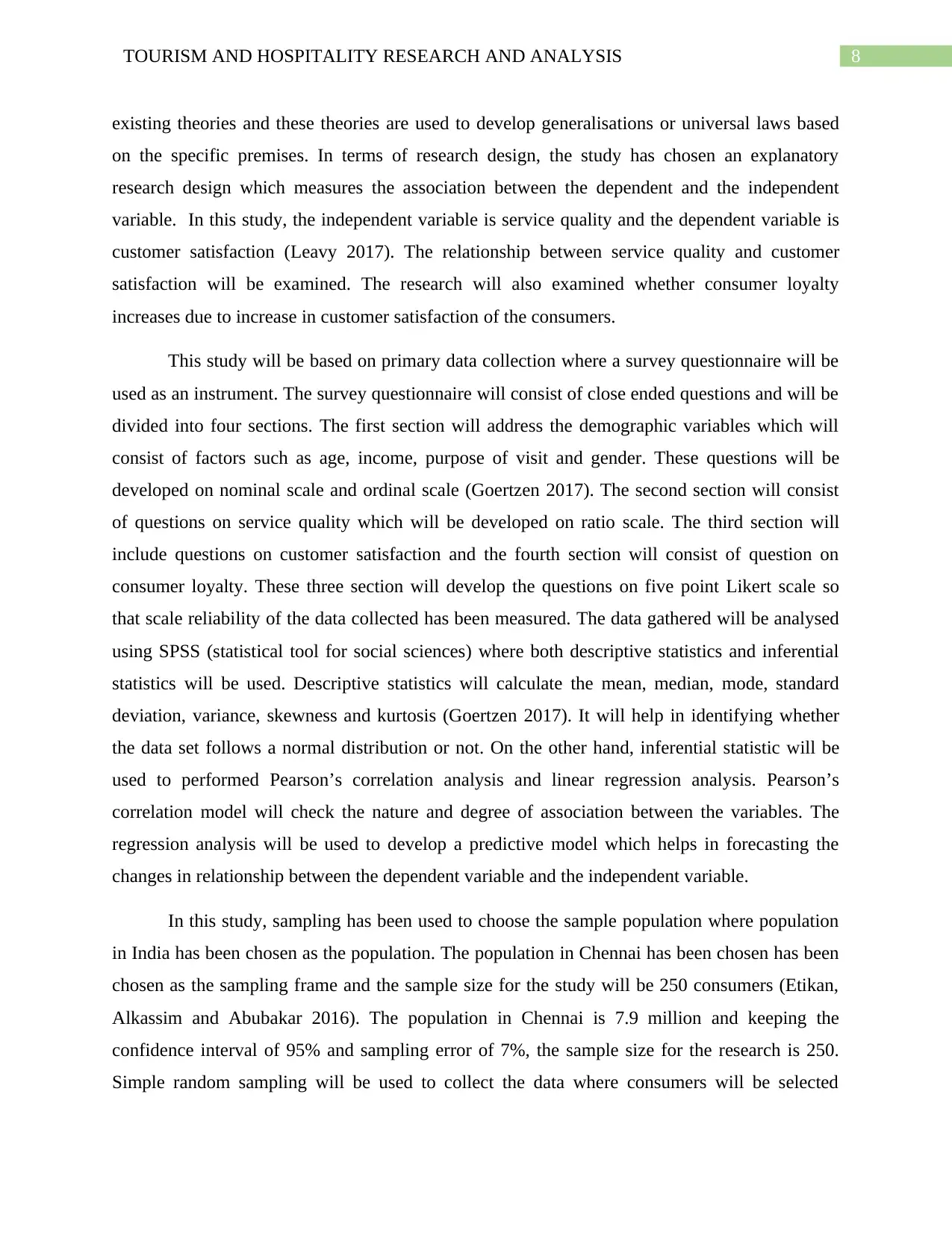
8TOURISM AND HOSPITALITY RESEARCH AND ANALYSIS
existing theories and these theories are used to develop generalisations or universal laws based
on the specific premises. In terms of research design, the study has chosen an explanatory
research design which measures the association between the dependent and the independent
variable. In this study, the independent variable is service quality and the dependent variable is
customer satisfaction (Leavy 2017). The relationship between service quality and customer
satisfaction will be examined. The research will also examined whether consumer loyalty
increases due to increase in customer satisfaction of the consumers.
This study will be based on primary data collection where a survey questionnaire will be
used as an instrument. The survey questionnaire will consist of close ended questions and will be
divided into four sections. The first section will address the demographic variables which will
consist of factors such as age, income, purpose of visit and gender. These questions will be
developed on nominal scale and ordinal scale (Goertzen 2017). The second section will consist
of questions on service quality which will be developed on ratio scale. The third section will
include questions on customer satisfaction and the fourth section will consist of question on
consumer loyalty. These three section will develop the questions on five point Likert scale so
that scale reliability of the data collected has been measured. The data gathered will be analysed
using SPSS (statistical tool for social sciences) where both descriptive statistics and inferential
statistics will be used. Descriptive statistics will calculate the mean, median, mode, standard
deviation, variance, skewness and kurtosis (Goertzen 2017). It will help in identifying whether
the data set follows a normal distribution or not. On the other hand, inferential statistic will be
used to performed Pearson’s correlation analysis and linear regression analysis. Pearson’s
correlation model will check the nature and degree of association between the variables. The
regression analysis will be used to develop a predictive model which helps in forecasting the
changes in relationship between the dependent variable and the independent variable.
In this study, sampling has been used to choose the sample population where population
in India has been chosen as the population. The population in Chennai has been chosen has been
chosen as the sampling frame and the sample size for the study will be 250 consumers (Etikan,
Alkassim and Abubakar 2016). The population in Chennai is 7.9 million and keeping the
confidence interval of 95% and sampling error of 7%, the sample size for the research is 250.
Simple random sampling will be used to collect the data where consumers will be selected
existing theories and these theories are used to develop generalisations or universal laws based
on the specific premises. In terms of research design, the study has chosen an explanatory
research design which measures the association between the dependent and the independent
variable. In this study, the independent variable is service quality and the dependent variable is
customer satisfaction (Leavy 2017). The relationship between service quality and customer
satisfaction will be examined. The research will also examined whether consumer loyalty
increases due to increase in customer satisfaction of the consumers.
This study will be based on primary data collection where a survey questionnaire will be
used as an instrument. The survey questionnaire will consist of close ended questions and will be
divided into four sections. The first section will address the demographic variables which will
consist of factors such as age, income, purpose of visit and gender. These questions will be
developed on nominal scale and ordinal scale (Goertzen 2017). The second section will consist
of questions on service quality which will be developed on ratio scale. The third section will
include questions on customer satisfaction and the fourth section will consist of question on
consumer loyalty. These three section will develop the questions on five point Likert scale so
that scale reliability of the data collected has been measured. The data gathered will be analysed
using SPSS (statistical tool for social sciences) where both descriptive statistics and inferential
statistics will be used. Descriptive statistics will calculate the mean, median, mode, standard
deviation, variance, skewness and kurtosis (Goertzen 2017). It will help in identifying whether
the data set follows a normal distribution or not. On the other hand, inferential statistic will be
used to performed Pearson’s correlation analysis and linear regression analysis. Pearson’s
correlation model will check the nature and degree of association between the variables. The
regression analysis will be used to develop a predictive model which helps in forecasting the
changes in relationship between the dependent variable and the independent variable.
In this study, sampling has been used to choose the sample population where population
in India has been chosen as the population. The population in Chennai has been chosen has been
chosen as the sampling frame and the sample size for the study will be 250 consumers (Etikan,
Alkassim and Abubakar 2016). The population in Chennai is 7.9 million and keeping the
confidence interval of 95% and sampling error of 7%, the sample size for the research is 250.
Simple random sampling will be used to collect the data where consumers will be selected
⊘ This is a preview!⊘
Do you want full access?
Subscribe today to unlock all pages.

Trusted by 1+ million students worldwide
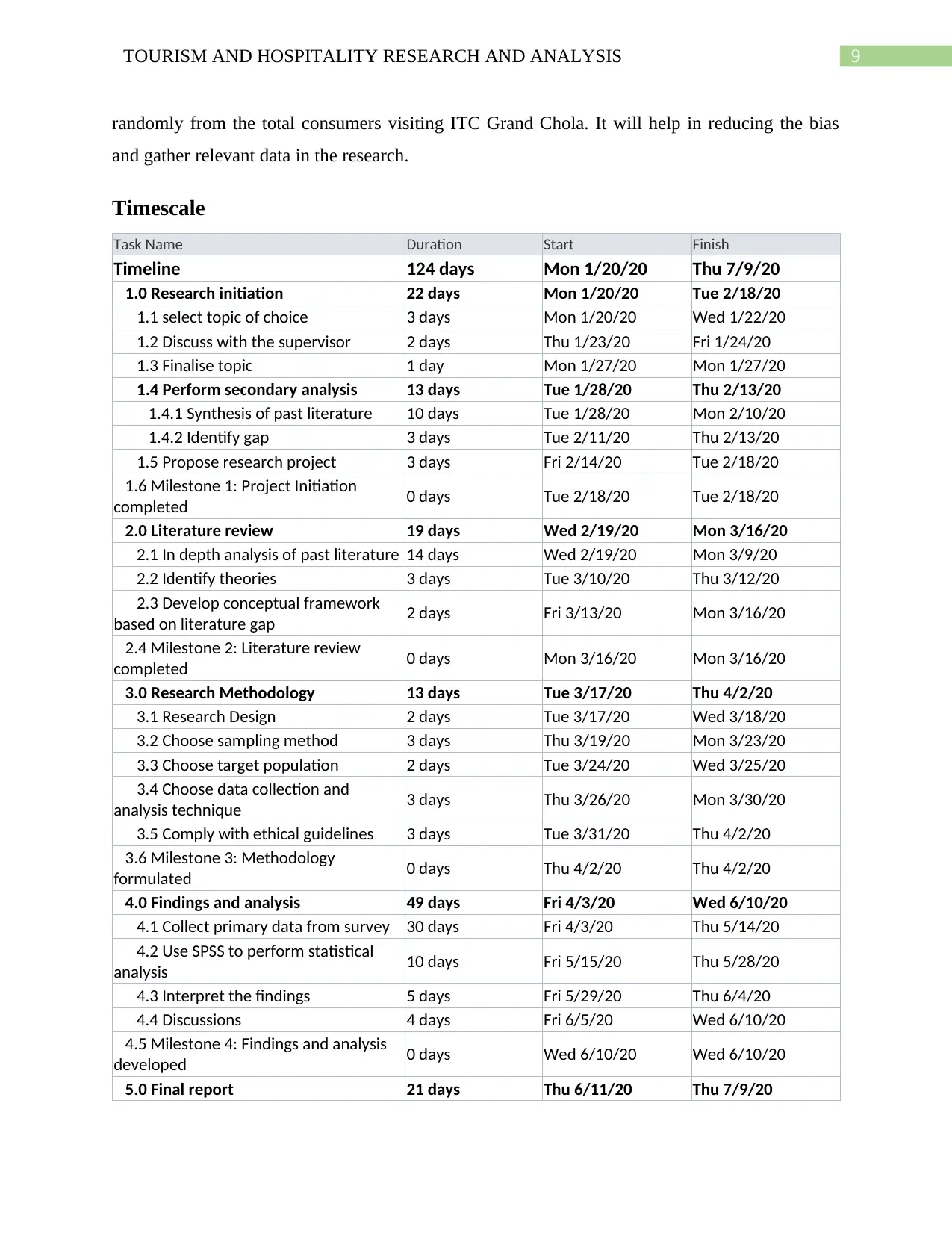
9TOURISM AND HOSPITALITY RESEARCH AND ANALYSIS
randomly from the total consumers visiting ITC Grand Chola. It will help in reducing the bias
and gather relevant data in the research.
Timescale
Task Name Duration Start Finish
Timeline 124 days Mon 1/20/20 Thu 7/9/20
1.0 Research initiation 22 days Mon 1/20/20 Tue 2/18/20
1.1 select topic of choice 3 days Mon 1/20/20 Wed 1/22/20
1.2 Discuss with the supervisor 2 days Thu 1/23/20 Fri 1/24/20
1.3 Finalise topic 1 day Mon 1/27/20 Mon 1/27/20
1.4 Perform secondary analysis 13 days Tue 1/28/20 Thu 2/13/20
1.4.1 Synthesis of past literature 10 days Tue 1/28/20 Mon 2/10/20
1.4.2 Identify gap 3 days Tue 2/11/20 Thu 2/13/20
1.5 Propose research project 3 days Fri 2/14/20 Tue 2/18/20
1.6 Milestone 1: Project Initiation
completed 0 days Tue 2/18/20 Tue 2/18/20
2.0 Literature review 19 days Wed 2/19/20 Mon 3/16/20
2.1 In depth analysis of past literature 14 days Wed 2/19/20 Mon 3/9/20
2.2 Identify theories 3 days Tue 3/10/20 Thu 3/12/20
2.3 Develop conceptual framework
based on literature gap 2 days Fri 3/13/20 Mon 3/16/20
2.4 Milestone 2: Literature review
completed 0 days Mon 3/16/20 Mon 3/16/20
3.0 Research Methodology 13 days Tue 3/17/20 Thu 4/2/20
3.1 Research Design 2 days Tue 3/17/20 Wed 3/18/20
3.2 Choose sampling method 3 days Thu 3/19/20 Mon 3/23/20
3.3 Choose target population 2 days Tue 3/24/20 Wed 3/25/20
3.4 Choose data collection and
analysis technique 3 days Thu 3/26/20 Mon 3/30/20
3.5 Comply with ethical guidelines 3 days Tue 3/31/20 Thu 4/2/20
3.6 Milestone 3: Methodology
formulated 0 days Thu 4/2/20 Thu 4/2/20
4.0 Findings and analysis 49 days Fri 4/3/20 Wed 6/10/20
4.1 Collect primary data from survey 30 days Fri 4/3/20 Thu 5/14/20
4.2 Use SPSS to perform statistical
analysis 10 days Fri 5/15/20 Thu 5/28/20
4.3 Interpret the findings 5 days Fri 5/29/20 Thu 6/4/20
4.4 Discussions 4 days Fri 6/5/20 Wed 6/10/20
4.5 Milestone 4: Findings and analysis
developed 0 days Wed 6/10/20 Wed 6/10/20
5.0 Final report 21 days Thu 6/11/20 Thu 7/9/20
randomly from the total consumers visiting ITC Grand Chola. It will help in reducing the bias
and gather relevant data in the research.
Timescale
Task Name Duration Start Finish
Timeline 124 days Mon 1/20/20 Thu 7/9/20
1.0 Research initiation 22 days Mon 1/20/20 Tue 2/18/20
1.1 select topic of choice 3 days Mon 1/20/20 Wed 1/22/20
1.2 Discuss with the supervisor 2 days Thu 1/23/20 Fri 1/24/20
1.3 Finalise topic 1 day Mon 1/27/20 Mon 1/27/20
1.4 Perform secondary analysis 13 days Tue 1/28/20 Thu 2/13/20
1.4.1 Synthesis of past literature 10 days Tue 1/28/20 Mon 2/10/20
1.4.2 Identify gap 3 days Tue 2/11/20 Thu 2/13/20
1.5 Propose research project 3 days Fri 2/14/20 Tue 2/18/20
1.6 Milestone 1: Project Initiation
completed 0 days Tue 2/18/20 Tue 2/18/20
2.0 Literature review 19 days Wed 2/19/20 Mon 3/16/20
2.1 In depth analysis of past literature 14 days Wed 2/19/20 Mon 3/9/20
2.2 Identify theories 3 days Tue 3/10/20 Thu 3/12/20
2.3 Develop conceptual framework
based on literature gap 2 days Fri 3/13/20 Mon 3/16/20
2.4 Milestone 2: Literature review
completed 0 days Mon 3/16/20 Mon 3/16/20
3.0 Research Methodology 13 days Tue 3/17/20 Thu 4/2/20
3.1 Research Design 2 days Tue 3/17/20 Wed 3/18/20
3.2 Choose sampling method 3 days Thu 3/19/20 Mon 3/23/20
3.3 Choose target population 2 days Tue 3/24/20 Wed 3/25/20
3.4 Choose data collection and
analysis technique 3 days Thu 3/26/20 Mon 3/30/20
3.5 Comply with ethical guidelines 3 days Tue 3/31/20 Thu 4/2/20
3.6 Milestone 3: Methodology
formulated 0 days Thu 4/2/20 Thu 4/2/20
4.0 Findings and analysis 49 days Fri 4/3/20 Wed 6/10/20
4.1 Collect primary data from survey 30 days Fri 4/3/20 Thu 5/14/20
4.2 Use SPSS to perform statistical
analysis 10 days Fri 5/15/20 Thu 5/28/20
4.3 Interpret the findings 5 days Fri 5/29/20 Thu 6/4/20
4.4 Discussions 4 days Fri 6/5/20 Wed 6/10/20
4.5 Milestone 4: Findings and analysis
developed 0 days Wed 6/10/20 Wed 6/10/20
5.0 Final report 21 days Thu 6/11/20 Thu 7/9/20
Paraphrase This Document
Need a fresh take? Get an instant paraphrase of this document with our AI Paraphraser
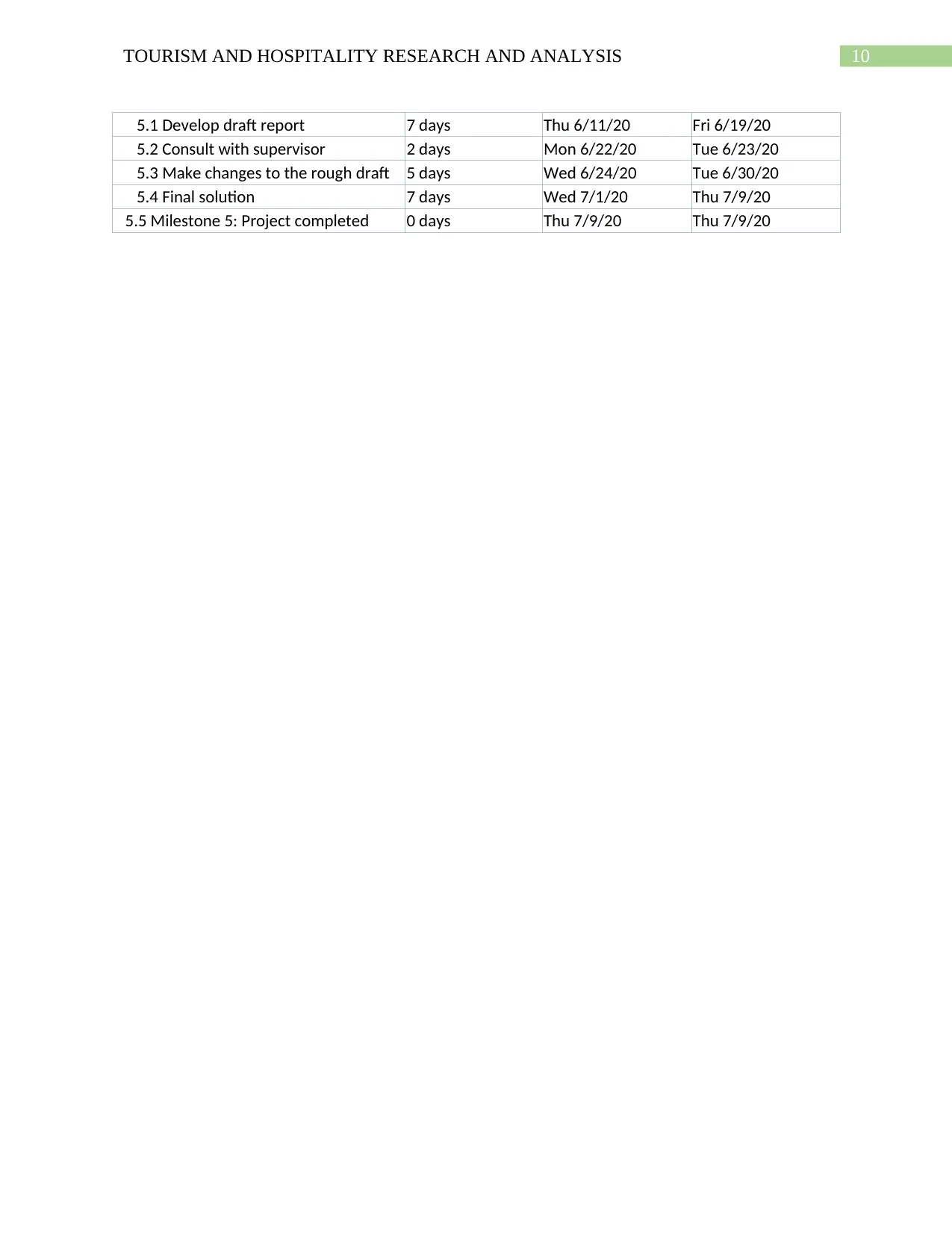
10TOURISM AND HOSPITALITY RESEARCH AND ANALYSIS
5.1 Develop draft report 7 days Thu 6/11/20 Fri 6/19/20
5.2 Consult with supervisor 2 days Mon 6/22/20 Tue 6/23/20
5.3 Make changes to the rough draft 5 days Wed 6/24/20 Tue 6/30/20
5.4 Final solution 7 days Wed 7/1/20 Thu 7/9/20
5.5 Milestone 5: Project completed 0 days Thu 7/9/20 Thu 7/9/20
5.1 Develop draft report 7 days Thu 6/11/20 Fri 6/19/20
5.2 Consult with supervisor 2 days Mon 6/22/20 Tue 6/23/20
5.3 Make changes to the rough draft 5 days Wed 6/24/20 Tue 6/30/20
5.4 Final solution 7 days Wed 7/1/20 Thu 7/9/20
5.5 Milestone 5: Project completed 0 days Thu 7/9/20 Thu 7/9/20
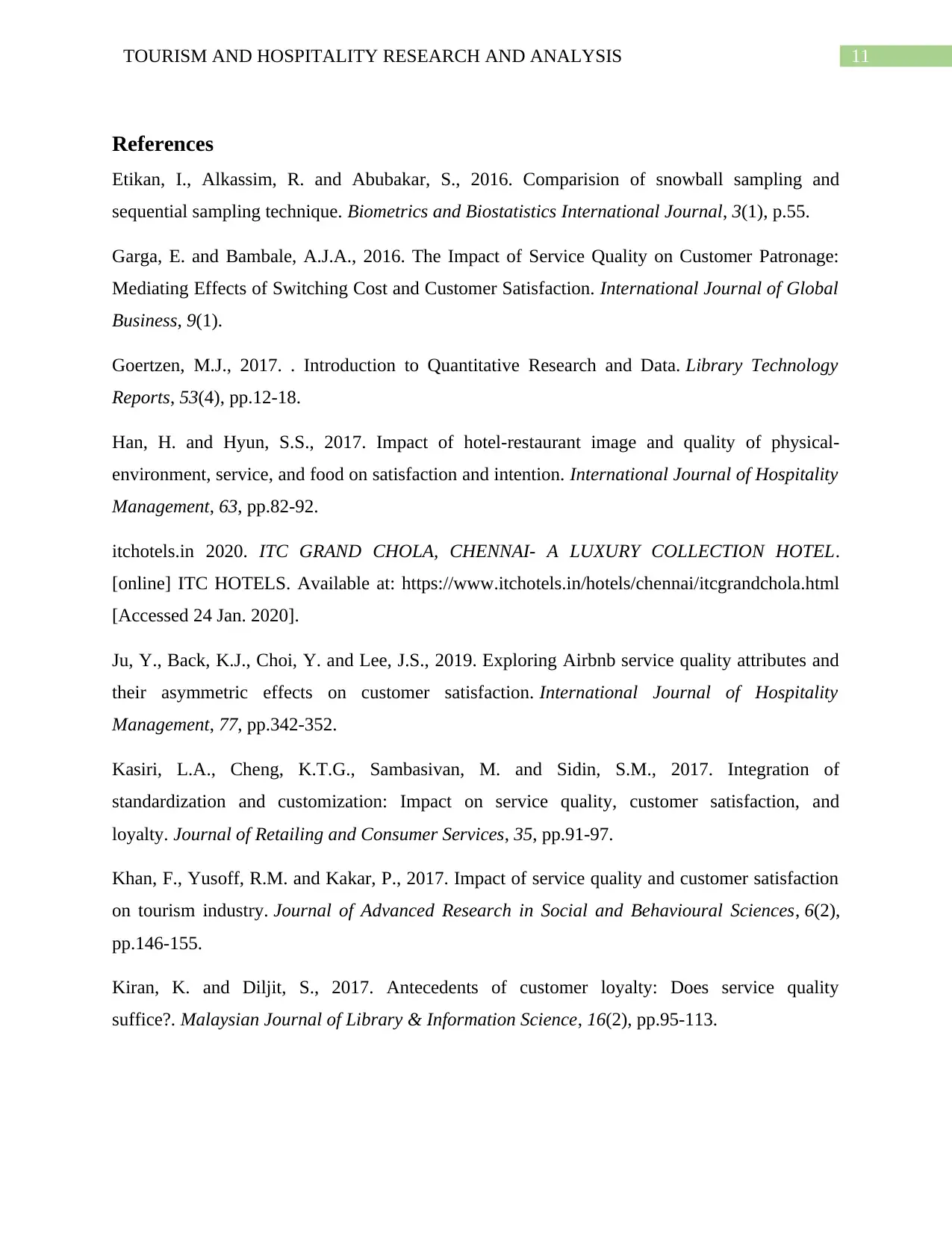
11TOURISM AND HOSPITALITY RESEARCH AND ANALYSIS
References
Etikan, I., Alkassim, R. and Abubakar, S., 2016. Comparision of snowball sampling and
sequential sampling technique. Biometrics and Biostatistics International Journal, 3(1), p.55.
Garga, E. and Bambale, A.J.A., 2016. The Impact of Service Quality on Customer Patronage:
Mediating Effects of Switching Cost and Customer Satisfaction. International Journal of Global
Business, 9(1).
Goertzen, M.J., 2017. . Introduction to Quantitative Research and Data. Library Technology
Reports, 53(4), pp.12-18.
Han, H. and Hyun, S.S., 2017. Impact of hotel-restaurant image and quality of physical-
environment, service, and food on satisfaction and intention. International Journal of Hospitality
Management, 63, pp.82-92.
itchotels.in 2020. ITC GRAND CHOLA, CHENNAI- A LUXURY COLLECTION HOTEL.
[online] ITC HOTELS. Available at: https://www.itchotels.in/hotels/chennai/itcgrandchola.html
[Accessed 24 Jan. 2020].
Ju, Y., Back, K.J., Choi, Y. and Lee, J.S., 2019. Exploring Airbnb service quality attributes and
their asymmetric effects on customer satisfaction. International Journal of Hospitality
Management, 77, pp.342-352.
Kasiri, L.A., Cheng, K.T.G., Sambasivan, M. and Sidin, S.M., 2017. Integration of
standardization and customization: Impact on service quality, customer satisfaction, and
loyalty. Journal of Retailing and Consumer Services, 35, pp.91-97.
Khan, F., Yusoff, R.M. and Kakar, P., 2017. Impact of service quality and customer satisfaction
on tourism industry. Journal of Advanced Research in Social and Behavioural Sciences, 6(2),
pp.146-155.
Kiran, K. and Diljit, S., 2017. Antecedents of customer loyalty: Does service quality
suffice?. Malaysian Journal of Library & Information Science, 16(2), pp.95-113.
References
Etikan, I., Alkassim, R. and Abubakar, S., 2016. Comparision of snowball sampling and
sequential sampling technique. Biometrics and Biostatistics International Journal, 3(1), p.55.
Garga, E. and Bambale, A.J.A., 2016. The Impact of Service Quality on Customer Patronage:
Mediating Effects of Switching Cost and Customer Satisfaction. International Journal of Global
Business, 9(1).
Goertzen, M.J., 2017. . Introduction to Quantitative Research and Data. Library Technology
Reports, 53(4), pp.12-18.
Han, H. and Hyun, S.S., 2017. Impact of hotel-restaurant image and quality of physical-
environment, service, and food on satisfaction and intention. International Journal of Hospitality
Management, 63, pp.82-92.
itchotels.in 2020. ITC GRAND CHOLA, CHENNAI- A LUXURY COLLECTION HOTEL.
[online] ITC HOTELS. Available at: https://www.itchotels.in/hotels/chennai/itcgrandchola.html
[Accessed 24 Jan. 2020].
Ju, Y., Back, K.J., Choi, Y. and Lee, J.S., 2019. Exploring Airbnb service quality attributes and
their asymmetric effects on customer satisfaction. International Journal of Hospitality
Management, 77, pp.342-352.
Kasiri, L.A., Cheng, K.T.G., Sambasivan, M. and Sidin, S.M., 2017. Integration of
standardization and customization: Impact on service quality, customer satisfaction, and
loyalty. Journal of Retailing and Consumer Services, 35, pp.91-97.
Khan, F., Yusoff, R.M. and Kakar, P., 2017. Impact of service quality and customer satisfaction
on tourism industry. Journal of Advanced Research in Social and Behavioural Sciences, 6(2),
pp.146-155.
Kiran, K. and Diljit, S., 2017. Antecedents of customer loyalty: Does service quality
suffice?. Malaysian Journal of Library & Information Science, 16(2), pp.95-113.
⊘ This is a preview!⊘
Do you want full access?
Subscribe today to unlock all pages.

Trusted by 1+ million students worldwide
1 out of 14
Related Documents
Your All-in-One AI-Powered Toolkit for Academic Success.
+13062052269
info@desklib.com
Available 24*7 on WhatsApp / Email
![[object Object]](/_next/static/media/star-bottom.7253800d.svg)
Unlock your academic potential
Copyright © 2020–2025 A2Z Services. All Rights Reserved. Developed and managed by ZUCOL.





